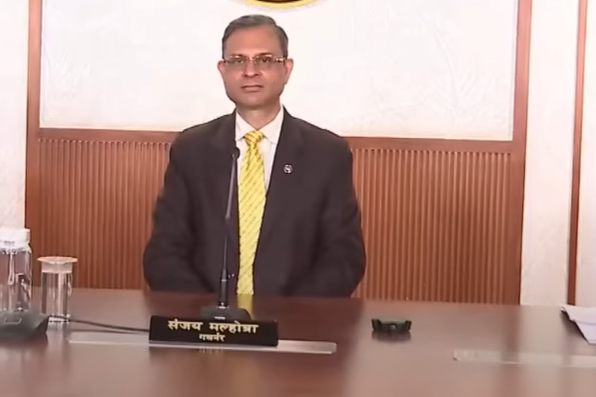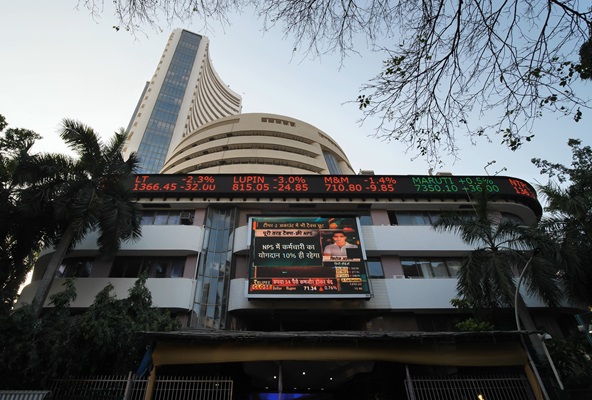.png)
Reading Sanjay Malhotra’s Silent Dialogue
India’s newest central banker reveals more than he says in his latest MPC press conference. Beneath his composure lies a technocrat negotiating with himself.


By Kirti Tarang Pande
Kirti Tarang Pande is a psychologist, researcher, and brand strategist specialising in the intersection of mental health, societal resilience, and organisational behaviour.
October 6, 2025 at 5:37 AM IST
This body-language analysis* is based solely on publicly available footage and reflects professional interpretation, not judgment or diagnosis.
When I first watched Sanjay Malhotra’s latest and most scrutinised MPC appearance as Reserve Bank of India Governor on October 1, I was struck not by what he said but by what his body refused to.
His tone was calm, his statements measured, his data crisp.
Yet his eyes blinked a little too often, his lips pressed a fraction too long, and his posture never quite relaxed into the authority his words aspired to project.
For a psychologist trained in reading non-verbal cues for empathy rather than judgement, this was an intriguing study in controlled discomfort, the body of a technocrat shouldering the weight of policy theatre.
In therapy, rigidity or emotional masking often signals vulnerability or resistance. In bureaucratic or public arenas, the same cues may instead serve as shields, tools of professional self-protection rather than concealment. Where a client hides emotion to avoid exposure, a policymaker hides it to maintain institutional composure.
The two gestures look identical but come from opposite instincts.
That distinction was the key to interpreting Malhotra’s behaviour without pathologising it.
To locate a fair baseline, I compared his demeanour with that of Raghuram Rajan and with central-bank statesmen such as Mario Draghi and Jerome Powell.
Draghi’s legendary “whatever it takes” moment was memorable not merely for its words but for the unwavering serenity with which he uttered them. Rajan projected academic poise; Powell, plain-spoken steadiness.
Each embodied what might be called the unified technocrat, a mind and body moving in one rhythm with institutional intent. Malhotra, by contrast, seemed the contained technocrat: analytical, meticulous, yet constantly managing his own containment.
He began with an attempt at humour about neckties, a small human gesture in a charged room. The chuckle was polite but fleeting; his body immediately recoiled into a poker-faced rigidity. The cue was classic self-monitoring: an effort to appear approachable quickly overruled by the instinct to re-establish control.
From that point on, restraint became the organising principle of his presence.
Hands remained still, palms folded downward on the desk. The posture was neither defensive nor open, simply fixed, a physical metaphor for policy caution. Behavioural science often associates limited hand movement with threat management, an unconscious attempt to minimise emotional leakage.
It signals that the speaker’s energy is turned inward, regulating rather than relating.
As the questions began, the strain beneath the composure surfaced in micro-bursts. Lip presses, filler sounds, and rapid blinks coincided with discussions on inflation projections and potential rate cuts, the very segments carrying the most policy sensitivity.
The sequence was consistent: an exhale, a brief tightening of the jaw, a blink cluster, and then a controlled response. Each time he quoted figures—particularly the fall in inflation estimates to 2.6%, his pitch rose slightly, the cadence firmed, as though numerical precision could fortify emotional confidence. Numbers became his cognitive anchor.
At one moment, he nodded “no” while asserting that inflation was easing, an incongruent gesture that betrayed a fleeting dissonance between institutional optimism and personal caution. To be clear, such contradictions can emerge from conversational rhythm rather than conviction. Yet, in a setting where every micro-movement is recorded and replayed, even habitual gestures acquire significance.
As the conference progressed, adaptation replaced stiffness.
When a journalist asked about demand and external headwinds, Malhotra met the gaze directly, scanning less and focusing more. This shift suggested cognitive settling, as the nervous system recalibrated from a state of vigilance to one of controlled engagement. Still, subtler inconsistencies persisted. His neck tilted in small, alternating nods and shakes as he spoke of India’s resilience. The words were confident; the muscles said almost.
A sharp increase in blink rate accompanied his assurance that India’s challenges were “not as high as other countries.” In behavioural analysis, such defensive reassurance cues often indicate awareness of potential contestation.
By the time questions turned to forward guidance and the accommodative stance, Malhotra’s composure had grown steadier, yet his body language tightened again. Palms remained hidden, fingers interlocked, punctuated by elongated “aaa” fillers that bought him milliseconds to compose. Lip-licking appeared twice, and self-soothing gestures were activated under evaluative stress. The eyebrows lifted subtly when he stressed that “guidance has been given,” a fleeting sign of both assertion and surprise, as if bracing against the pressure of disclosure.
His least comfortable stretch came during the exchange on the Corporate Exposure Framework. Here, his hesitations multiplied. He glanced at deputies for affirmation, offered layered explanations, and finally conceded he did not have the precise numbers.
That admission, coupled with a small shoulder roll and downward glance, reflected momentary insecurity, a self-aware technocrat navigating an incomplete brief in a public crucible.
The late rounds of questioning revealed cognitive fatigue.
Blinks grew faster, self-corrections more frequent—“I’m sorry… I’m sorry”, a pattern familiar to psychologists observing high working-memory load. Under such stress, the prefrontal cortex focuses on error prevention, often at the expense of fluid delivery. Hand adjustments and chair shifts increased, classical self-soothing rituals designed to modulate anxiety. The conference ended with a long blink and a visible breath, the unmistakable physiology of relief.
Despite these leaks of strain, Malhotra projected competence and method.
His reliance on figures was not merely intellectual but neuropsychological: for analytic personalities, quantitative anchors stabilise decision-making under uncertainty. The IITian in him reached for data as a shield against ambiguity. He was at his most fluent when situating India within a global context, contrasting domestic resilience with external fragility. Such framing activates the brain’s reward and social-cognition circuits, reinforcing self-efficacy. In those moments, his tone brightened, posture eased, and the shoulders lifted slightly—the only instances of visible comfort.
Viewed through this composite lens, Malhotra’s press performance reads as the body language of a professional still transitioning from technocrat to statesman. The contrast with predecessors underscores the gap. Rajan’s academic gravitas carried built-in composure; Draghi radiated serene conviction; Powell projects reassurance through deliberate cadence. Malhotra’s signals, by contrast, speak of calculation more than confidence, a man mastering control before mastering connection.
This difference is not trivial. In the public life of monetary policy, persuasion rests as much on non-verbal coherence as on linguistic clarity. Markets listen to tone and tempo, not only text or actions. When gestures contradict speech, even subtly, they seed interpretive uncertainty. For an institution that prizes stability, any incongruence, however human, becomes part of the message.
Psychologically, Malhotra appears to operate from a high self-monitoring baseline, a trait common among technocrats thrust into public scrutiny. The mind continuously evaluates its own expression, producing what neuroscientists term executive interference: the act of thinking about thinking while speaking. This heightens cognitive load and narrows the scope of spontaneous warmth. Over time, as the environment becomes familiar, the system adapts; spontaneity returns. There were hints of that evolution mid-conference, as he adjusted eye contact and tone.
It would be simplistic to read these cues as deception or doubt. What they reveal instead is a complex negotiation between institutional duty and personal conviction. Every central banker performs within a triangle of constraint: the market’s expectations, the committee’s consensus, and the self’s belief. Malhotra’s non-verbals suggested a man triangulating that space in real time.
His restraint may be prudence.
Policy-watchers, however, may read the stress differently. The unease around forward guidance and corporate-exposure relaxations hints at unresolved internal debates within the RBI. His reliance on deputies during those moments reflects either collegial distribution or underlying divergence. The outward calm, therefore, becomes a double signal—stability for the markets, self-control for the institution.
The performance ended as it began: composed, courteous, and contained. Yet in the microsecond between his final word and the closing breath, the façade softened. Shoulders dropped, the jaw relaxed, and for a fleeting instant, the man reclaimed the body the office had borrowed. That is the moment I trust most in body-language work—the silent afterword when the performance briefly ceases. It is there, in that half-second of relief, that the human reveals itself beneath the title.
Malhotra, for now, remains the analytical engineer of Mint Street, prioritising precision over persuasion. His communication strategy aligns with the institution’s preference for caution amid uncertain global and domestic conditions. Over time, as familiarity breeds confidence, his gestures may acquire the ease that turns a technocrat into a statesman. Until then, the body will continue to whisper what the words must withhold.
Disclaimer*
This body-language analysis is based solely on publicly available video footage of the October 1, 2025 MPC press conference. I was not physically present at the event. The observations represent a professional interpretation grounded in psychological and behavioural science, not a judgment of character, intent, or truthfulness.
Body language is inherently context-dependent and influenced by individual variability. The insights offered here are for informational and educational purposes only, not diagnostic or advisory in nature.
** The views expressed are those of the author and do not reflect the position of BasisPoint Insight
Also Read:
Is the Hunt for a Terminal Repo Rate a Distraction?
Review of MPC Decision: What Does it Mean to be Forward-Looking?
RBI Fixes its June Communication Misfire



